Zucchinis are most gardeners’ early summer delights. Zucchinis keep producing throughout the summer if provided in the right conditions. Since the Zucchinis are fast growers, it is essential to learn when it is ready to pick and avoid overripe.
Zucchinis are ready to pick after 45-55 days, but timing varies. Learning the maturity signs, like the size, color, and texture, is the best way out because it can be either less or more than 45-55 days. Pick them in the morning, when the dew dries, and before the temperature rises significantly.
In this article, we will share some advice about when Zucchinis are ready to pick and tips about the best ways to harvest them. You will learn everything till the end of the article, even if it is your first year growing.
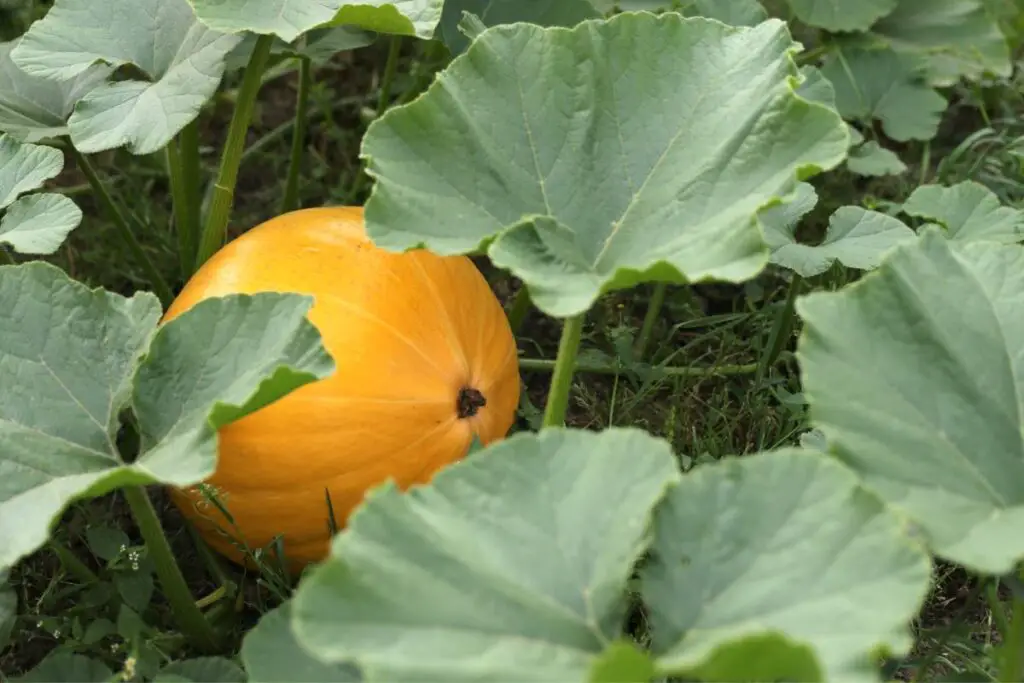
Zucchini Growth Stages
Zucchinis are oblong and dark green vegetables, sometimes patterned with green and white.
There are also small round Zucchinis with yellow and green color.
Some are oval and bicolored, like half yellow and half green.
I love growing different vegetables in my garden.
Growing them in your garden lets you get healthy, tasty, chemical-free vegetables. Moreover, you can also save money.
Besides, gardening is interesting and exciting as you can receive a touch of nature and a refreshing mind.
I have grown many vegetables and fruits, and Zucchini is one of them.
While growing up, I was curious about their every growth stage.
It has been an incredible journey from when I sowed the seeds to when I harvested.
When you check the Zucchini’s growth level regularly, you will receive an idea about their different growth stages.
I have received it, too, and I will briefly share it in this section for you for a clear understanding.
Before you begin growing Zucchinis, you should choose the right seeds.
The Zucchini seeds should be flattened, firm, and shiny with an off-white color.
It should be fresh and not less than 4 years because fresh seeds have higher chances of germination.
Now, let’s get to the different growth stages:
- Sowing seeds: It begins with sowing the seeds. You can either sow them in a pot and grow them indoors or directly sow them in the ground outdoors. Sow the seeds in loose, moist soil, 1 inch deep and 10-12 inches apart.
- Germination: When the roots sprout, ensure evenly moist soil and good sunlight for the seeds. Seeds will take around 10 to 14 days to germinate.
- Cotyledons: The first leaves, or cotyledons, will come out from the soil after germination and last for 5 to 7 days. The new plant will need bright light.
- True leaves: 3-5 days after the cotyledons emerge, these will be the first true leaves after the cotyledons fall off. The plant will now start proliferating. So, make sure they receive all requirements adequately.
- Vegetative growth: The plant is now vigorously growing stems, vines, and leaves. The plants will grow around 2 to 3 feet tall and 2-3 feet wide. The longer vines will reach about 6 feet or more. They will also crawl on the ground, but tying them to a trellis will encourage them to grow upwards.
- Flowering: Small yellow flowers will grow when the plant reaches this stage. The first flowers will be the male flowers, and after 1-2 weeks, the flowers blooming will be the female flowers.
- Fruiting: The fruits will appear from the female flowers’ base after pollination. Once the fruits appear, expect them to mature within 7 to 10 days because Zucchinis are very fast growers.
- Harvest: Now, it is time to pick the Zucchinis. Harvest them every other day, but do not let them stay in the plant for too long. If there are too many, you can store them for later use.
In today’s article, we will share every detail about the last stage, i.e., Harvest. So, keep reading.
The right time to harvest Zucchinis
Usually, the right time to harvest the Zucchinis is 45 to 55 days after planting the seeds. But it can depend on two essential factors:
1. Variety:
Zucchinis have various varieties, and their maturity timing differs.
However, there is not a huge difference. For example:
- Eight balls: 40 days
- Seneca: 42 days
- Gold Rush: 45 days
- Zucchini Gray: 49 days
- Costata Romanesco: 52 days
2. Growing conditions:
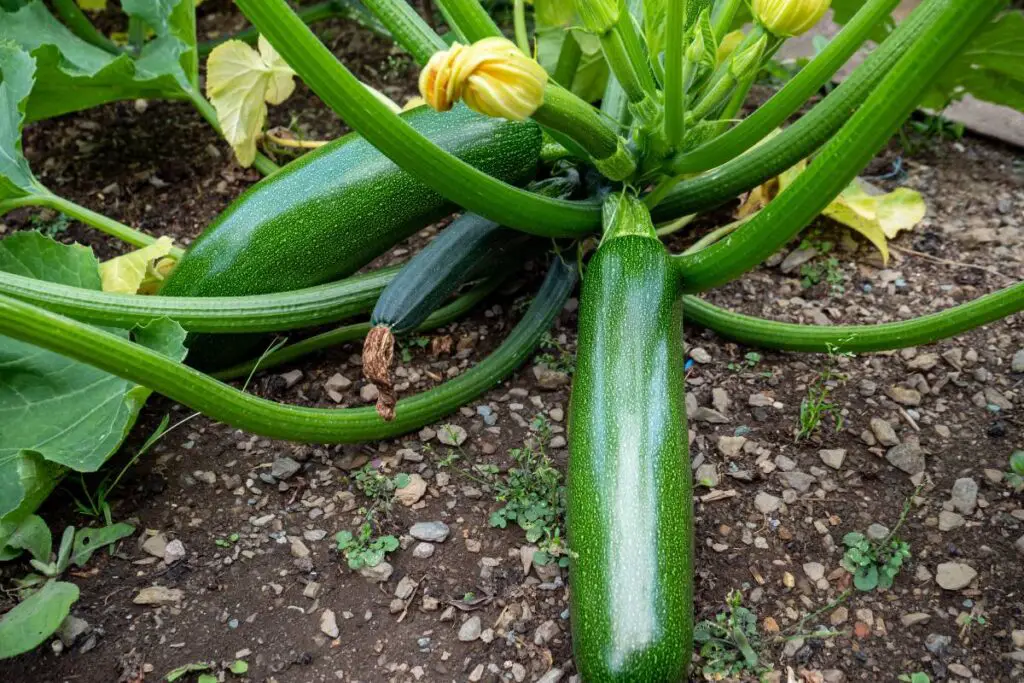
If your Zucchinis have received the right amount of sunlight, water, soil type, and nutrients, it will grow and mature faster.
However, those who didn’t receive enough requirements or have suffered some issues in the growth process will take time to mature.
If you grow Zucchinis, you will know that it is common for the fruits to grow large when you do not harvest them in a few days.
The kids always want the biggest for themselves, thinking big is better.
Even some beginners think the same.
But remember that the big ones are not always the better ones.
Bigger ones are hard to consume and grow too many seeds.
So, you cannot enjoy them properly.
Since Zucchinis grow quite big within a few days, they should be picked often.
The exact time to harvest will depend on personal preference.
I enjoy picking fruits when they are young, around 6-8 inches long, and the color is still dark green.
Zucchinis should be picked in the warmer months of late spring, summer, and early autumn.
It can vary based on your living region.
For example, if you are from a temperate zone, your Zucchinis will be ready for harvest in July.
Sometimes, you can expect them to prepare in late June, based on when you have sown the seeds.
Since several factors can affect the harvest time, get ready to pick them 45-55 days after planting and check for the maturity signs before picking them.
Also, consider the timing of the day.
Harvest them in the morning when the dew drops have dried, and the temperature has not risen immensely.
Signs of Zucchini maturity: When is Zucchini ready to pick?
While growing Zucchinis, I have learned that identifying the signs of fruit maturity is very important.
It allows you to understand the right time to pick them.
While growing them, I have harvested them both late and early.
Both will have some cons.
Too early harvest can lead to small Zucchinis, whereas late harvest gives you hard Zucchinis with many seeds.
So, it is essential to learn the signs to harvest them at the right time.
In this section, I will share some signs of Zucchini’s maturity.
So, let’s begin:
Observing Size and Length
The size and length of the Zucchinis are visible signs of maturity.
Zucchinis are best harvested when 6-8 inches long and 2 inches in diameter.
When you keep the fruits on the vine for too long, they will be oversized and won’t taste good to eat.
The fruit will become hard and grow lots of seeds inside.
The right size (especially in diameter) to pick Zucchinis will depend on the variety, for example:
- Pattypan Zucchinis are best picked when they are 2-3 inches in diameter.
- Round Zucchinis are best picked when they are 2-6 inches in diameter. For making soups, let them grow around 4 to 6 inches across.
- Crookneck Zucchinis are best harvested when they are 4 to 6 inches in diameter.
Color and Texture
Another symptom that helps you identify when Zucchini is ready to pick is the color and texture of the fruit.
When the Zucchinis mature, they have a dark green or yellow color.
When the fruits become pale or light green, they are yet to mature.
Harvesting young Zucchinis will give you small fruits.
The texture should be firm and smooth.
The skin should be delicate and dark green.
A soft and wrinkled texture means the fruit is overripe.
Tender skin also means that the Zucchinis are still young.
The skin can get easily scratched in the case of the latter.
The skin won’t get easily scratched when the Zucchini is perfect for picking.
If the skin or texture is too hard, you have waited too long to pick them.
Looking for gardening supplies? We have tested 100's of products before recommending them to you guys. Check out our best pick below:
| Image | Gardening Supplies | Best Price? |
|---|---|---|
 Top
Top Top
Top | Raised Garden Bed Kit | Check On Amazon |
 | XLUX Soil Moisture Meter, Plant Water Monitor, Soil Hygrometer Sensor for Gardening, Farming, Indoor and Outdoor Plants, No Batteries Required | No Results |
 Top
Top Top
Top | 82 Pcs Garden Tools Set and Extra Succulent Tools Set | Check On Amazon |
 | Joeys Garden Expandable Garden Hose with 8 Function Hose Nozzle, Lightweight Anti-Kink Flexible Garden Hoses, Extra Strength Fabric with Double Latex Core, (50 FT, Black) | No Results |
 Top
Top Top
Top | Dual Chamber Compost Tumbler | Check On Amazon |
 Top
Top Top
Top | Sunnyglade Plant Stakes | Check On Amazon |
 Top
Top Top
Top | Organic Cold Pressed Neem Seed Oil | Check On Amazon |
 Top
Top Top
Top | Mighty Mint Gallon :-Insect and Pest Control Peppermint Oil | Check On Amazon |
 Top
Top Top
Top | Scotts DiseaseEx Lawn Fungicide | Check On Amazon |
 Top
Top Top
Top | Jacks Classic 20-20-20 All Purpose Fertilizer | Check On Amazon |
 Top
Top Top
Top | 30,000 Seeds Pollinator Attracting Wildflower Mixture | Check On Amazon |
 Top
Top Top
Top | Survival Vegetable Seeds Garden Kit-Over 16,000 Seeds | Check On Amazon |
Zucchini density and weight
When the Zucchini plant has matured, and the fruits are ready to pick, you will feel the Zucchini to be dense and heavy for its size.
The high density of the fruit is due to its moisture content.
It will also feel firm when squeezed.
Remember that too much firmness or hard texture means you have harvested late.
Late or early harvest
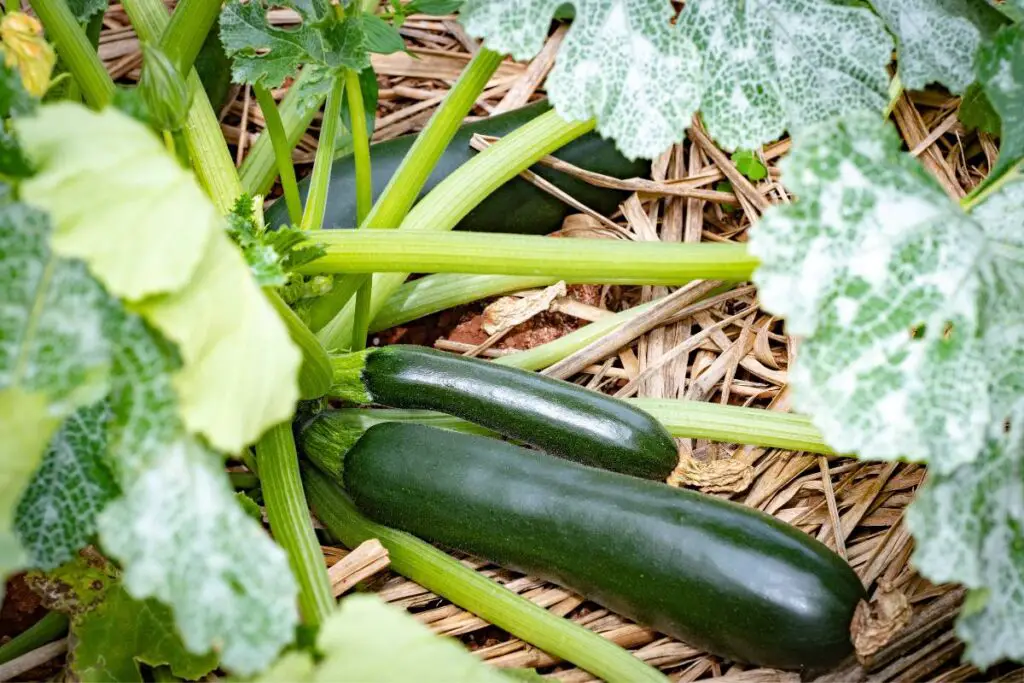
Seeing the first Zucchini fruit of the year in your garden can tempt you to harvest it right away.
But that is not right.
When harvested too early, the Zucchinis will be smaller in size.
It will leave you with many days where you have nothing to pick.
On the contrary, harvesting Zucchinis late gives you shineless and matte-colored fruit.
The fruit will still be edible, but you won’t enjoy it.
The overripe Zucchini will be very hard to eat, and it will grow lots of seeds inside.
Additionally, keeping the fruit in the plant will reduce the plant’s food production and leave you with fewer fruits.
Once, I picked a very large Zucchini after a very long time.
Zucchinis have large leaves, and this one was hiding behind the leaves.
I have almost picked up all the fruits I have seen; only this one was left.
It can happen to you, too.
So, while picking, check the leaves too to see if any fruit is left for picking.
Just because a large overripe Zucchini becomes inedible at a point doesn’t mean the fruit will get wasted.
The larger Zucchinis can be great for Zucchini bread or muffins.
Moreover, you can collect and save the seeds for sowing them in the next season.
Frequent Harvesting
Zucchinis are very fast producers.
So, you must harvest them frequently to maintain the plant’s health and productivity.
Keeping the fruits in the plant for too long reduces the plant’s production ability.
The ideal size to pick Zucchinis is when they are 6 to 8 inches long and 2 inches wide.
The fruit will be tender and have a mild flavor at this stage.
The fruit becomes harsh, bitter, and unsuitable when left on the plant for too long.
At the beginning of the Zucchini’s growth season, there will be a few fruits in the plant.
But suddenly, the production will accelerate.
This overwhelming fruit production pace will excite the growers to keep the plant a little more for bigger fruits.
Refrain from making this mistake.
Once you see the plant producing fruits, check the plant daily and harvest the mature ones.
You can harvest them multiple times within the growing season.
For a more technical observation, keep track of the days, from sowing seeds to seeing flowers and female flowers producing the first fruit.
Keep checking the fruit’s texture, color, and size.
Once 45 to 55 days have passed from the sowing time, the fruits will be mature and ready to harvest.
Once you see fruits in the plant, check and pick them every other day or every 3 days.
You can understand their maturity through the signs and receive a continuous supply of the fruit.
Continue picking to receive tasty fruits and a large harvest by the end of the summer.
I receive too many Zucchinis throughout the season.
I frequently harvest and share some with the kids and families from my neighborhood.
Avoiding Overripe Zucchini
Overripe Zucchinis are not tasty to eat.
They become very hard to eat, and the fruit grows many seeds, making eating more uncomfortable.
The only way to avoid picking overripe Zucchinis is to harvest them on time.
After 45 to 55 days, the fruits should be ready to pick.
Check the plant regularly; when it starts growing fruits, check them every other day.
Since Zucchinis are fast growers, they can mature within a day or two.
Harvest the fruits when they reach around 6 to 8 inches long and 2 inches in diameter.
Harvesting them at the right time will prevent you from receiving overripe and hard fruits with many seeds.
How to harvest Zucchinis?

Once you have found that the Zucchinis have reached the ideal size for picking, it is time to do it.
Gather a basket and a pruning tool. It is better not to snap or twist the fruits from the plant.
Instead, use a proper tool to pick up the fruits.
Twisting or snapping may break the fruits incorrectly, leading to plant injury and fruit rotting.
However, a lot of gardeners snap it clean off the plant.
If you have the experience of doing it this way, go for it.
I won’t recommend it because I have consistently failed at this method.
Find the ideal Zucchini size and cut the stem where it attaches to the plant.
Leave about 1 inch of the stem on the fruit to prevent it from rotting and increase the shelf life.
While cutting, be careful because the fruits are still soft and tender.
A minor injury from the tool or your fingernail can injure the fruit and increase the rot risk.
After picking, collect them in the basket slowly, avoiding any physical damage.
You can store the Zucchini in the refrigerator and keep it fresh for 7 days.
Please do not wash the Zucchinis unless you intend to use them.
While harvesting, try to remove some big leaves.
It will allow you to see fruits that may hide behind these leaves and allow the plant to breathe.
Harvesting Zucchini Flowers
Along with the fruit, you can also harvest the Zucchini flowers.
Harvesting the flowers is very simple.
All you need to do is snip them off the plant.
I prefer using pliers for a clear-cut and then collecting them in a container or basket.
Zucchinis will have male and female flowers and the fruits are born from the female flowers.
While both are edible, most prefer to harvest the male flowers and leave behind the female flowers for growing the fruits.
Make sure not to harvest too many male flowers.
That can hinder pollination and fruit production.
If you cannot identify the flowers, check for flowers that have a very small Zucchini at its base. These are the female flowers.
Check for the flowers with a bulbous base if there are no fruits.
These are the female flowers.
The male flowers will grow on a long stem with a thinner base.
Once you are done harvesting, you can either cook these flowers or enjoy them raw.
I stuff them with cream cheese and herbs to fry or saute them.
Sometimes, I also dip them in tempura batter and fry them.
You can also roast the flowers in the oven or add them to the stir-fry recipes.
Fresh flowers can be sliced into ribbons and used as toppings for risotto, omelets, salads, and tacos.
Harvest the flowers early or mid-morning, and choose the fresh flowers for the best results.
The flowers will not stay fresh for too long.
So, use them on the day you have picked.
Harvesting for Different Culinary Uses
Generally, the best time to pick the Zucchinis is when they reach 6 to 8 inches in length and 2 inches in diameter.
But this can depend on how you prefer consuming the Zucchinis.
Do you want to enjoy them fresh, or do you want to make dishes by cooking them?
Here are a few things I have learned in my journey of growing the Zucchinis:
Fresh consumption
Usually, the Zucchinis are picked when they have reached the ideal size and are still small and tender.
These Zucchinis are best enjoyed fresh, both raw and cooked.
The small Zucchinis have fewer seeds, can be sauteed quickly, and are sweet to taste.
Thus, it will be a great addition to the salads.
Cooking and baking
Let the fruits reach a few more inches, but not too big to use the Zucchinis for cooked dishes, casseroles, or baking.
Zucchinis that are 8 to 10 inches are great for cooking and baking.
Regularly check the plants and pick them when they reach the ideal size.
Since they are fast growers, you must check them daily and pick them up at the time.
Once they grow too big, you cannot enjoy eating them.
Stuffed Zucchini
For stuffing the Zucchini with other food items, let the fruits reach only a few inches bigger, like 8 to 10 inches.
Do not use overly big fruits, as that won’t be useful.
These Zucchinis will give the fruits enough hollow space to stuff and maintain good flavor and texture.
Zoodles
You can cut the Zucchini and make noodles, also called Zoodles.
You use long, thin pieces of Zucchinis in the shape of noodles and cook them like noodles.
It can be a change for noodles for people who do not want to eat them anymore; they are on a low-carb diet and trying to eat healthily.
To give it the shape of noodles, use a spiralizer.
For zoodles, you need to use young Zucchinis measuring 6 to 8 inches in height and 2 inches in diameter.
The fruits will be easier to spiralize and cook.
Seeds
To collect more Zucchini seeds to plant them again in the next season, you must let the fruits stay in the plant for as long as possible.
You will need large Zucchinis with a hard texture.
It is the only time that allows you to harvest the Zucchinis as late as possible.
They need to reach at least 14 to 15 inches to grow seeds.
Common Mistakes and Misconceptions
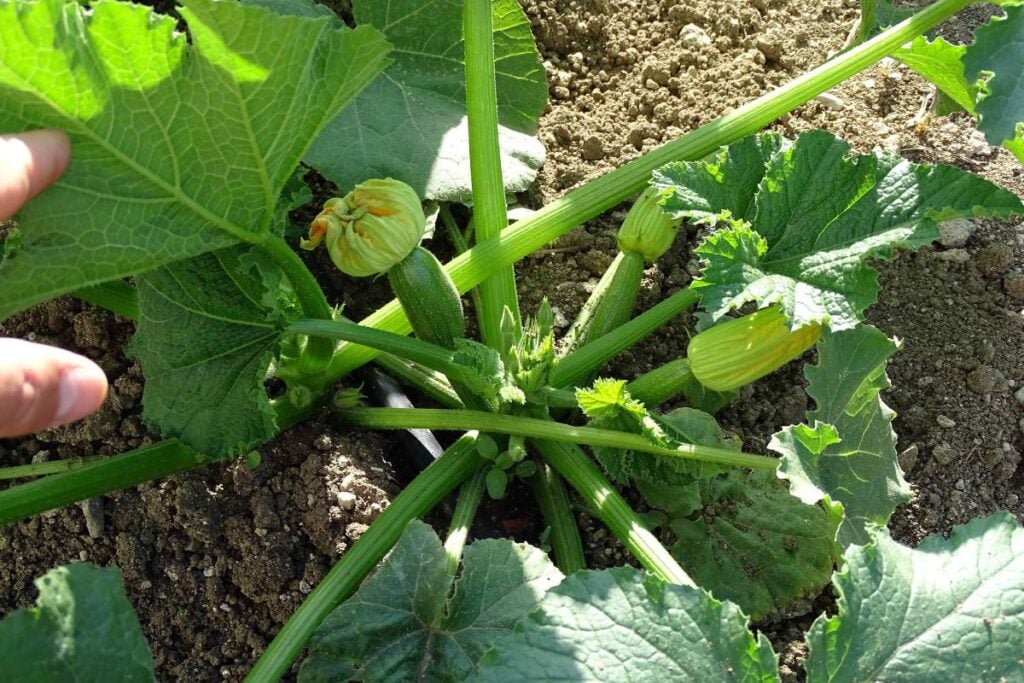
As a beginner at growing Zucchinis, I made many mistakes because of some misconceptions.
For example, I thought that bigger Zucchinis were better.
As I kept growing them, I learned that young Zucchinis are better than the larger ones.
The large fruits are best for saving seeds, but the young ones are best for consumption.
Like these, there are several other misconceptions for which beginners will make a few mistakes.
Let’s look at the common misconceptions and the mistakes to avoid:
Harvesting too late
As I said, it is always better to pick the Zucchinis when they reach 6 to 8 inches in length and 2 inches in diameter.
Keeping them in the plant for too long will only give you hard fruits with many seeds.
Moreover, leaving them in the plant for too long reduces the plant’s production ability.
Not harvesting regularly
Zucchinis are pretty fast growers.
Overnight, they can grow a few inches.
If you see the Zucchinis 4 inches today, you might see them reaching 5 to 6 inches the next day.
Ignoring harvesting for a few days will lead to oversized and hard Zucchinis.
So check and keep harvesting them every day or every other day.
Not checking the leaves
The leaves of the Zucchinis are large.
The fruits can hide behind it.
While harvesting, you pick up only those you see and avoid checking the leaves.
The next day or after a few days, you will notice some fruits behind them.
But unfortunately, at this stage, you may not be able to consume them.
Since Zucchinis are fast growers, those hiding behind the leaves will get oversized.
So, please check behind the leaves to ensure no fruits are left behind.
Harvesting all at once
Just because the Zucchinis can grow a few inches within 1-2 nights does not mean you will harvest all of them at once.
Picking them every other day will allow you to receive different sizes of fruits to enjoy them over a more extended period.
For example, if you have too many Zucchinis of the same ready-to-pick size, harvest some to consume fresh today.
After 1-2 days, harvest the fruits that have grown slightly bigger and enjoy baking them.
You can also share some with your neighbors.
But let the plant have some young fruits. It will divert the plant to mature the existing fruits and make more new fruits.
Assuming all the Zucchinis are the same
Zucchinis can vary based on the varieties.
For example, the taste of the Zucchinis will vary slightly based on the variety you are growing.
Some varieties will taste sweet, but others will be sweeter and tender.
So, research a bit and then grow the one you want to enjoy.
Throwing away large Zucchinis
The overgrown Zucchinis will be hard to eat and have lots of seeds.
I had a misconception that these Zucchinis should be discarded after collecting the seeds. That’s not the case.
Even if these fruits have become stiff and tasteless, you can still use them for culinary purposes in recipes that need grating or shredding, such as Zucchini fritters.
Best Practices for Harvesting
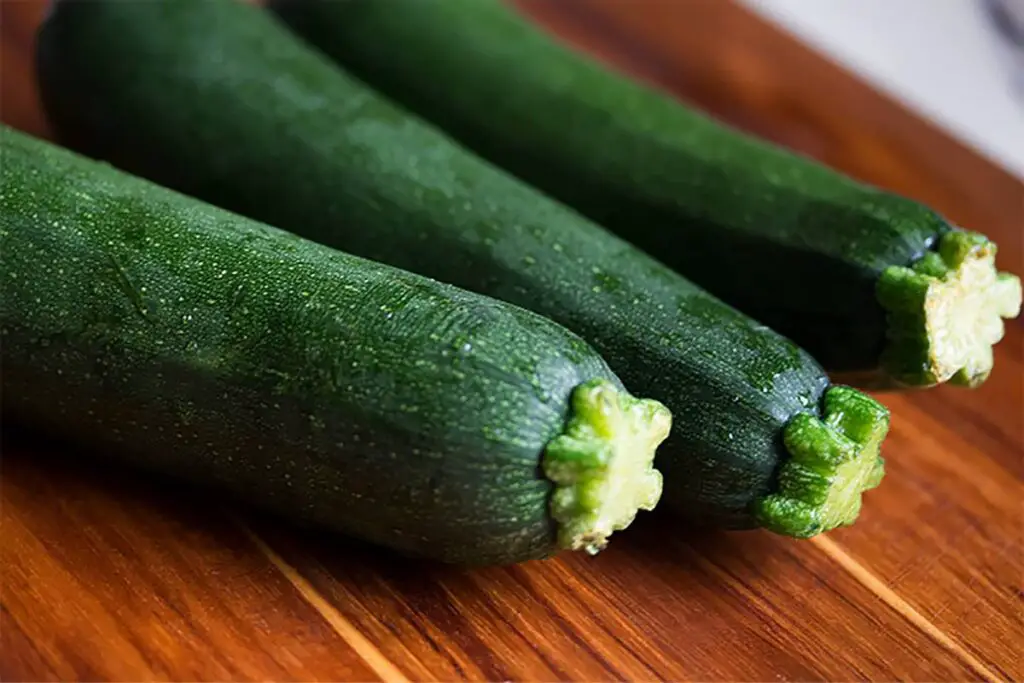
Picking the Zucchinis at the right time and with the proper techniques will allow you to enjoy fresh and best-quality Zucchinis.
Here are some best practices to follow while picking Zucchinis to enjoy the best quality fruits:
- Since the Zucchinis are fast growers, check the fruit growth condition every other day when the plant starts producing. Also, check behind the big leaves.
- Harvest the Zucchinis when they are young (not too small), around 6-8 inches. Harvest them frequently to avoid large and hard Zucchinis.
- When you harvest the Zucchinis, use pruning shears or a knife for a clean cut. It prevents injury and encourages the plant to grow more fruits.
- Try to take good care of the plants and adequately meet their requirements. Otherwise, your plants will be stressed and produce distorted, small, or tasteless fruits.
- When picking the Zucchinis, let the fruits have a short stem. It will stop the fruits from rotting.
- Harvest the Zucchinis in the early morning or late afternoon when the temperature is still cool. It will preserve their freshness and avoid receiving heat stress.
- Just because the Zucchinis are best enjoyed when they are young and fresh does not mean you will always pick them early. Try picking some of them late for seeds.
- When harvesting, harvest some from all the plants. For example, pick 1-2 fruits from every plant if you have three Zucchinis. This way, each plant will get a fair chance of production.
Final thoughts
The journey from sowing seeds to harvesting and consuming them is satisfying. Harvesting becomes impressive when the Zucchini reaches its peak ripeness and flavor. The right time to pick the Zucchinis is 45 to 55 days after planting. But this can vary based on the plant’s growth speed and how you want to use them.
Zucchinis are enjoyed the best when they are 6-8 inches long and 2 inches in diameter. The color should be dark green, and the texture should be firm. You can even harvest and enjoy the flowers. Go for the male flowers and leave the female flowers from producing fruits. Do not harvest too many flowers, as that will hinder pollination.
Late harvest will give you big Zucchinis, which will be hard to eat and full of seeds. However, they are not a waste. You can still use them for cooking and collect and store the seeds for the next season. While harvesting, use a cutting tool and make a clean cut, ensuring the fruits have at least 1-inch stems left to prevent rotting.
Can I harvest the Zucchini before an overnight frost?
Zucchinis are sensitive to frost and thus do not suffer in low temperatures. When a light frost is forecasted, protect the plant with frost covers, and during a hard frost, harvest the fruits.
Why are Zucchinis turning yellow and fading before harvesting time?
Maybe the plant is suffering from blossom end rot. It happens when there is a fluctuation in the moisture levels. So, inspect your plant and control the watering. Water the plant only when the top few inches have dried.
Reference: Zucchini Wikipedia
